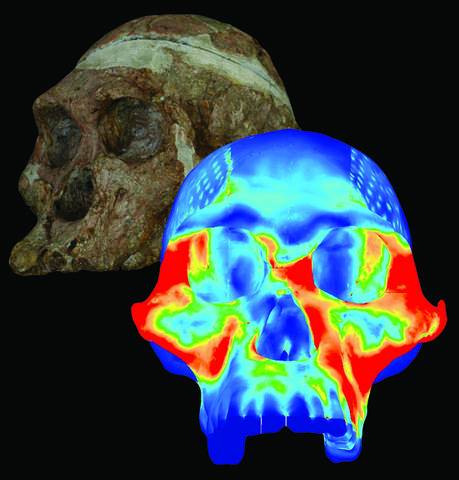
Finite element model of a cranium of the early hominid Australopithecus africanus based largely on the specimen Sts 5 (background). Color mapping indicates the magnitude of strains associated with biting on a hard object with the premolar teeth. A combination of engineering, experimental, comparative and imaging analysis suggest that premolar loading was an important component of early hominin feeding behavior.
In an unusual intersection of materials science and anthropology, researchers from the National Institute of Standards and Technology (NIST) and The George Washington University (GWU) have applied materials-science-based mathematical models to help shed light on the dietary habits of some of mankind's prehistoric relatives. Their work forms part of a newly published, multidisciplinary analysis of the early hominid Australopithecus africanus by anthropologists at the State University of New York at Albany and elsewhere.
In the new study, Albany researcher David Strait and his colleagues** applied finite element analysis—an engineer's modeling tool that employs an intricate geometric mesh to calculate the stresses and strains at play in complex shapes—to the teeth and jaws of A. africanus, an African hominid that lived 2 to 3 million years ago. Their goal was to determine just how, and with how much force, the animal chomped and chewed its food. Such analyses are of great importance to anthropologists. Teeth are the hardest parts of the body, and so are the parts most likely to be found after millions of years. Careful examination of subtle features of teeth and jaws can reveal what an animal could eat, which implies what it did eat, which implies a host of things about its environment, habits and survival strategies.
A. africanus presented a puzzle. Classical analysis of the skull—large molars and premolars with thick enamel, thick heavy jawbones, strong chewing muscles as evidenced by their anchor points on the bone—pointed to a diet of small, hard seeds. The finite-element analysis threw a spanner in the works. It suggested that A. africanus's facial and jaw anatomy was optimized to handle stress on the premolars, teeth located farther forward in the mouth and most useful for chewing larger hard objects. But recent studies had shown that the teeth lacked the microscopic wear patterns characteristic of chewing hard objects, a contradiction.
Here, work by NIST researcher Brian Lawn and a group at GWU headed by Peter Lucas came in handy. Driven by an interest in tooth restoration materials, they had been studying teeth using fracture mechanics, a field that considers how materials fail under excessive loads. "Our analytical approach produces equations that predict how each mode of damage will occur under different conditions and this enables us to determine trends for different tooth sizes, different food sizes, different food hardness and so on," explained Lawn. "What they show is that, under some conditions, teeth will actually fracture before they wear." This explained the absence of microwear patterns in the teeth, which would normally not be used for chewing small hard seeds. "A lot of people have thought the most important part of the survival of the tooth is wear, but it's now becoming evident that the fracture properties are also very important because there's a limit to the force that you can apply. Wear is important, but when you start to bite on harder, larger objects, fracture becomes more important," Lawn said.
"This is a neat example of how really basic materials science—fracture mechanics—has important implications for biological sciences and anthropology," Strait observed. In the bigger picture, said Strait, the new understanding about A. africanus's diet may help to explain its successful adaptation to changing climates. A large hard nut that had to be cracked with the premolars may not have been a preferred meal, but it could be something to fall back on when other foods were scarce.
Read more about the study in the SUNY Albany news release, "Early Humans Were Nuts About Seeds."
** Contributors to the complex effort included researchers from the State University of New York at Albany, the University of Vienna, the Max-Planck-Institute for Evolutionary Anthropology, the Smithsonian Institution, Arizona State University, Baylor College of Dentistry, the University of Chicago, the University of Massachusetts, the Kansas City University of Medicine and Biosciences, the Mercer University School of Medicine and Mercer University as well as NIST and The George Washington University.
D.S. Strait, G.W. Weber, S. Neubauer, J. Chalk, B.G. Richmond, P.W. Lucas, M.A. Spencer, C. Schrein, P.C. Dechow, C.F. Ross, I.R. Grosse, B.W. Wright, P. Constantino, B.A. Wood, B. Lawn, Q. Wang, D.E. Slice, C. Byron and A.L. Smith. The feeding biomechanics and dietary ecology of Australopithecus africanus. Proceedings of the National Academy of Sciences. Published online Feb. 2, 2009, doi:10.1073/pnas.0808730106

